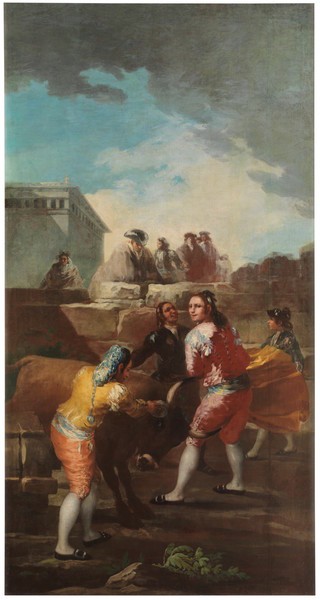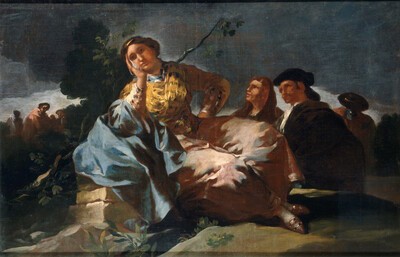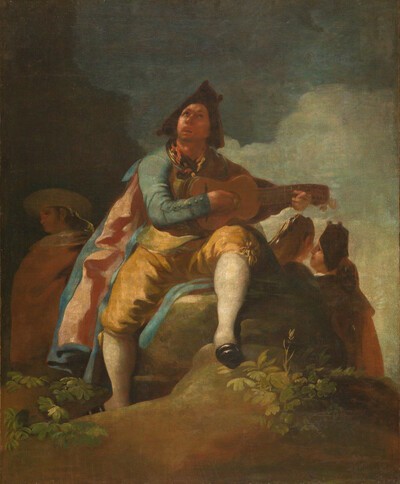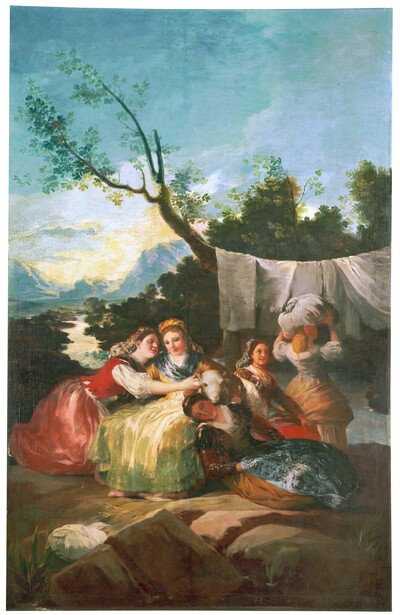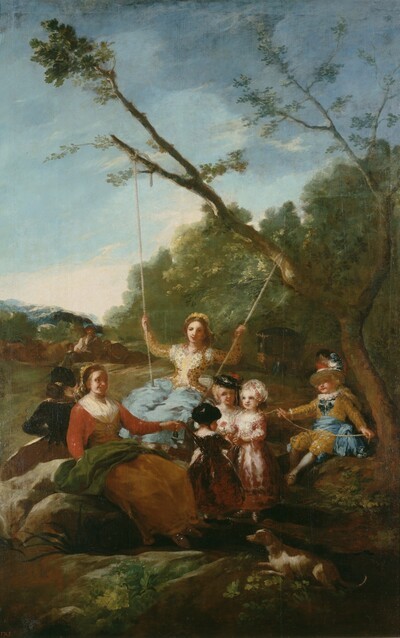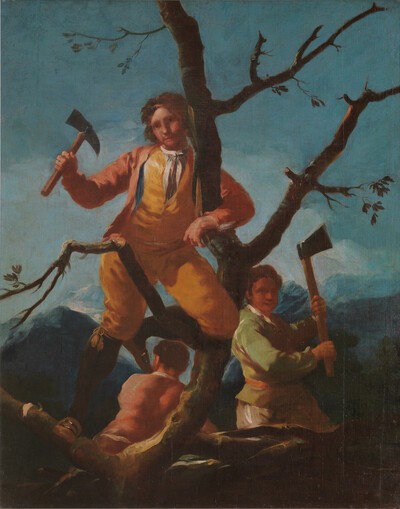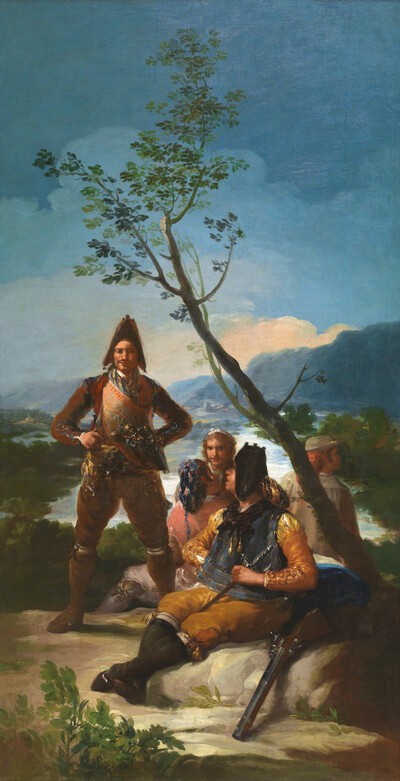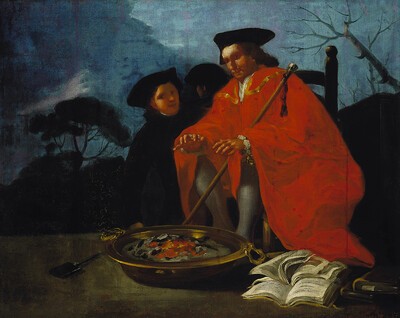- Cronología
- 1778 - 1780
- Ubicación
- The Prado National Museum. Madrid, Madrid, Spain
- Dimensiones
- 259 x 136 cm
- Técnica y soporte
- Oil on canvas
- Reconocimiento de la autoría de Goya
- Documented work
- Titular
- El Prado National Museum
- Ficha: realización/revisión
- 29 Nov 2009 / 01 Jun 2023
- Inventario
- (P00787)
See The Blind Guitarist.
This cartoon was delivered to the Royal Tapestry Factory on 24 January 1780, along with ten other cartoons, completing the decoration of the antechamber to the bedroom. These eleven tapestry cartoons - almost certain to have been made between 21 July 1779, when the artist delivered A Stickball Game and The Swing, and this delivery in January 1780 - were executed very rapidly. It is very likely that Goya was aware of the planned suspension of manufacturing work at the factory and was anxious to finish his commissions and receive his wages.
Around 1856 or 1857, the cartoon was moved from the Royal Tapestry Factory of Santa Bárbara to the Royal Palace in Madrid. In 1870, it was taken to the Prado Museum under orders given on 18 January and 9 February.
The Young Bull shared the south wall of the room with The Tobacco Guards.
The subject of bulls and bullfighting was one that Goya, himself a keen aficionado, went back to time and again, and this was his first work along these lines. It is true that the result is not one of his best pieces; the young bull appears heavy and static whilst the toreros show little skill. The one on the right, dressed in red, could be a self-portrait of Goya fighting the animal, but this is not a commonly accepted theory since some writers maintain that Goya would not have depicted himself as a common majo. When he did paint himself into one of his works, five years later, it was as a court servant in the works The Sermon of Saint Bernardine of Siena and The Count of Floridablanca. His great fondness for bullfighting, however, may have led him to depict himself as a torero.
The theme was a polemic one, since Charles III did not like the bullfights, even though the Prince and Princess of Asturias did. This may explain why Goya did not choose a bullfight proper but rather something more in keeping with a fair, where it is the braver young men of the town or city rather than professional toreros confronting the bulls.
The background features a building that, as Camón points out, recalls Aragonese architecture, particularly in the way the tall windows are arranged. The same writer says that the best thing about this cartoon is the colouring employed on the suits of the young men - silky and iridescent, with deftly painted highlights.
Tomlinson believes that The Young Bull represents virility, in contrast to the lasciviousness and feminine sensuality embodied by the women in The Swing and The Washerwomen on the opposite wall.
-
Goya and his timesThe Royal Academy of ArtsLondon1963cat. 66cat. 48
-
Goya in the PradoThe National Gallery of ArtWashington1976from May 6th to 31st 1976cat. 1
-
GoyaPalacio de PedralbesBarcelona1977from April 12th to June 30th 1977cat. 8
-
Goya: toros y torerosEspace Van GoghArles1990displayed also at Academia de Bellas Artes de San Fernando, Madrid, consultant editor Pierre Gassier.cat. 1 (sólo expuesto en Madrid)
-
Goya. 250 AniversarioMuseo Nacional del PradoMadrid1996consultant editor Juan J. Luna. From March 29th to June 2nd 1996cat. 27
-
Francisco de Goya: Maleri, Tegning, GrafikkNasjonalgallerietOslo1996from 10th to April 14th 1996cat. 4
-
Goya luces y sombrasCaixaForumBarcelona2012consultant editors José Manuel Matilla and Manuela B. Marqués. From March 16th to June 24th 2012cat. 57
-
Goya en Madrid. Cartones para tapices 1775-1794Museo Nacional del PradoMadrid2014cat. 111
-
Zaragoza2017cat. 20
-
L'œuvre peint de Goya. 4 volsParís1928-1950vol. I, p. 80, cat. 21
-
Tapices de GoyaMadridPatrimonio Nacional1946pp. 115, 233, cat. 30 y láms. 126-127
-
Vie et ouvre de Francisco de GoyaParísOffice du livre1970pp. 76, 89, cat. 133
-
L’opera pittorica completa di GoyaMilanRizzoli1974pp. 95-96, cat. 91
-
Francisco de Goya, 4 vols.ZaragozaCaja de Ahorros de Zaragoza, Aragón y Rioja1980-1982vol. I, pp. 110-111 y p. 160 (il.)
-
Francisco de Goya, cartones y tapicescol. col. "Espasa Arte"Espasa Calpe1987pp. 105-106, 113, 275, cat. 34C y p. 106
-
Francisco de Goya. Los cartones para tapices y los comienzos de su carrera en la corte de Madridcol. col. "Ensayos de Arte Cátedra"MadridCátedra1987137, 140-142 y p. 138 (il.)
-
Goya, toros y torerosMadridMinisterio de Cultura, Comunidad de Madrid1990p. 48
-
Goya. Catálogo de la pinturaZaragozaReal Academia de Nobles y Bellas Artes de San Luis1994p. 153, cat. 86
-
Goya. 250 AniversarioMadridMuseo del Prado1996pp. 307-308, cat. 27 y pp. 102-103 (ils.
-
Salas del Palacio Real de El Pardo para las que se tejieron tapices sobre cartones de Francisco de Goya: identificación de las habitaciones y ajuste de las obras de Goya en los alzados de las paredesin HERRERO CARRETERO, Concha (curator, Tapices y cartones de Goya (catalogue of the exhibition organizated at the Palacio Real de Madrid, from may to june 1996)MadridPatrimonio Nacional, Goya 96, Lunwerg1996p. 169 (il.)
-
Goya en Madrid. Cartones para tapices 1775-1794MadridMuseo Nacional del Prado2014p. 111
-
BilbaoFundación bancaria “la Caixa” y Museo Nacional del Prado2018p. 73
